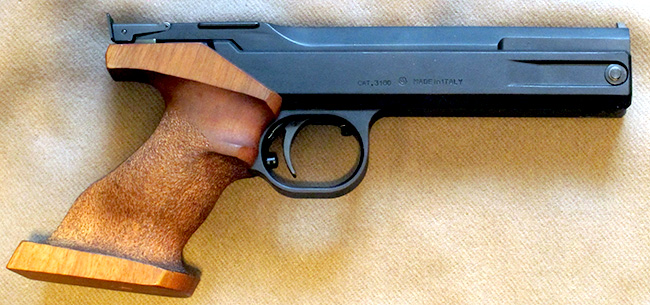
The FAS 604 single stroke pneumatic air pistol.
Part 1
SigAir SuperTarget air pistol revisited Part 3
This report covers:
- Velocity
- Benjamin Bullseye
- JSB Simply
- RWS R10 Match Pistol
- Velocity summary
- Accuracy test
- Benjamin Bullseyes
- JSB Simply
- RWS R10 Match Pistol
- JTS Dead Center Wadcutter
- Accuracy summary
- Series Summary
Today we look at both the velocity and accuracy of the freshly resealed FAS 604 single stroke pneumatic air pistol. I’ll begin with velocity.
Velocity
I tested the pistol with four different pellets. Two of them were also tested for accuracy in the Sig SuperTarget, so you’ll get another comparison. I only shot two pellets for each type because we were about to get freezing rain.
I had to test outdoors because the lights I use for my chronograph have failed and their replacements have not arrived. I will give an average for each pellet but it’s just the average of those two shots.
Benjamin Bullseye
Benjamin Single Die pellets averaged 318 f.p.s. in the 604. The low was 316 and the high was 320 f.p.s. for a spread of just 4 f.p.s.
JSB Simply
Next to be tested was the 8.26-grain JSB Simply wadcutter. They averaged 347 f.p.s. with a low of 344 and a high of 349 f.p.s. That’s a difference of 5 f.p.s.
RWS R10 Match Pistol
The third pellet I tested was the RWS R10 Match Pistol wadcutter. They averaged 377 f.p.s. with a low of 374 and a high of 380 f.p.s. That’s a spread of 6 f.p.s.
The last pellet tested was the JTS Dead Center wadcutter. They averaged 349 f.p.s. The low was 348 and the high was 351— a difference of just 3 f.p.s.
Velocity summary
The 604 is testing very much like the SuperTarget I tested back in 2019. With 7-grain RWS Hobby pellets that pistol averaged 338 f.p.s. with a 10 f.p.s. spread. This 604 is just a little faster. I would say Ian McKee did a very good job of resealing this pistol! He will show us what that looks like in a future report!
Accuracy test
The accuracy test was five shots from a rested pistol at 10 meters. I had to sight in the pistol because the rear sight was screwed all the way down and a little to the right. Fortunately I had an American penny that fits the adjustment screw slots perfectly.
It took six shots to get into the black bullseye of a 10-meter pistol target. I didn’t worry about hitting dead center because I was shooting four different pellets.
Benjamin Bullseyes
The 604 put five Benjamin Bullseyes into a 10-meter group that measures 1.146-inches between centers of the two shots farthest apart. The SuperTarget put five Bullseyes into a 0.844-inch group under the same conditions.
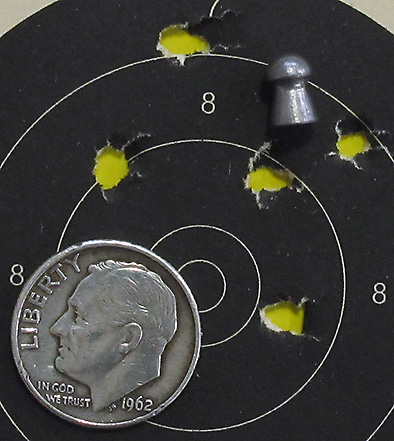
The FAS 604 put five Benjamin Bullseye pellets into a 1.146-inch group at 10 meters.
JSB Simply
The 604 put five JSB Simply wadcutters into a 10-meter group that measures 0.771-inches between centers. The SuperTarget put five of the same pellets into a group that measures 0.646-inches under the same conditions.
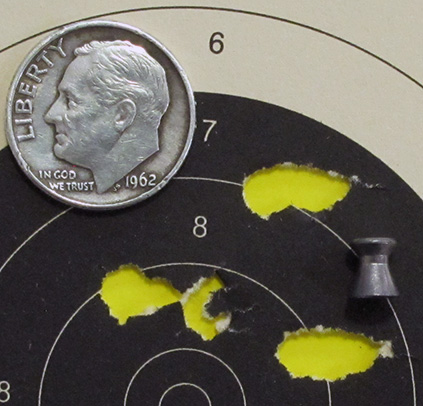
The FAS 604 put five JSB Simply pellets into a 0.771-inch group at 10 meters.
RWS R10 Match Pistol
The 604 put five RWS R10 Match Pistol pellets into 1.38-inches at 10 meters. I’d have to say this pistol doesn’t like that pellet.
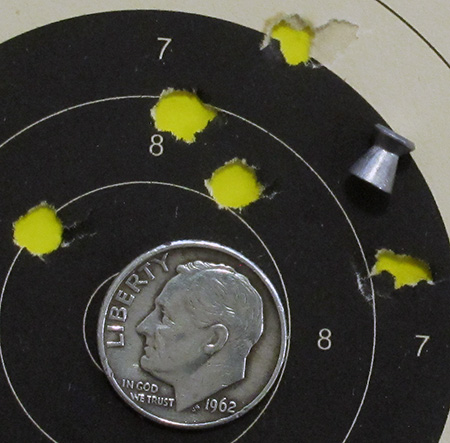
The 604 put five RWS R10 Match Pistol pellets into 1.38-inches at 10 meters.
JTS Dead Center wadcutter
The last pellet I shot for accuracy was the JTS Dead Center wadcutter. The 604 put five of them into a 1.576-inch group at 10 meters. It is the largest group of the test.
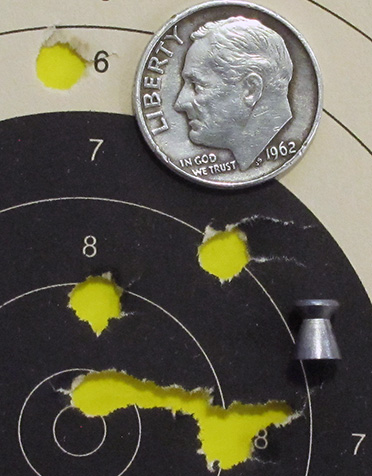
The 604 put five JTS Dead Center wadcutters into a 1.576-inch group at ten meters. The pistol definitely doesn’t like this pellet!
Accuracy summary
This 604 tested slightly less accurate than my SuperTarget. Since we know that both pistols have the same brand of barrel, either I was a bit off or this pistols is. Either way it’s still a joy to shoot.
Series Summary
This concludes my test of the FAS 604 air pistol. As I suspected, the performance was close to the SuperTarget and the fit and finish is noticeably better. In my opinion the FAS 604 is a fine target pistol for informal target shooting, but it does not warrant the high prices I see on the used airgun market.
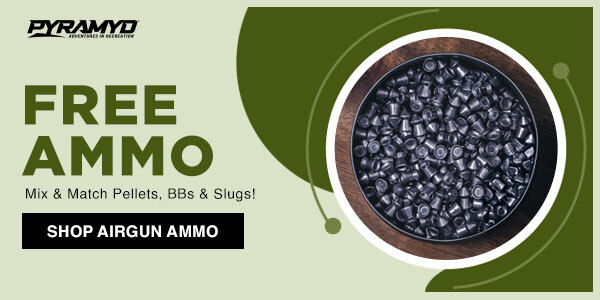
Tom,
Given the time and weather constraint shooting under duress is rarely associated with accuracy. Hopefully Ian will have more time with this pistol and will be able to find the pellet this pistol likes.
Siraniko
B.B.
What are the used prices that you are seeing?
-Yogi
Yogi,
Don’t sweat it. It will pinch your fingers. 😉
Yeah, I know!
-Y
Yogi,
They start at $550 and go up over $700.
BB
BB,
$550-$700??? For a “target” air pistol that a $40 Beeman P17 will beat the snot out of?
Just goes to show you can’t judge a book by its cover.
No shortage of people though who will go for “reassuringly expensive” every time.
My Izzy only cost me $300 new when I bought it. It is a real target air pistol also. I might consider selling it for $700, maybe.
B.B.,
That is in the same range (but in £) as the SIG ASP Super Target was commanding in the UK and other out CONUS countries over the past two years. One dealer in the USA had one for sale for under US$ 300.00 (no SIG case or manual) but rumored to be one very underpowered example; wonder if they knew about the warm-up and chamber lube. Another example was on sale for $249.00 but marked down to $229.00 and then SOLD pronto.
Both the FAS and SIG versions have a love-hate history in the various forums mostly revolving around Muzzle Velocity and some claims of fragile or poor surface(s) finish.
I haven’t had any of those issues with my SIG Super Target.
shootski
I will still keep my Izzy.
RidgeRunner,
Good idea…i’m keeping mine as well.
I had an Izhmash BIATHLON rifle but sold it and got my Anschütz 1827 Fortner decades ago ;^)
shootski
BB,
I think I will stick with my Izzy. At one point I would have liked to have one of these, but that does not seem to be any better than a Webley.
I thought you were using one of those LabRadar things. I do recall you remarking about your light problem, but I did not catch it in my head. Whazup?
P.S. JSB Simply – Last sentence
That (is) a difference of 5 f.p.s.
RR,
Fixed it. Thanks,
BB
RidgeRunner,
Shhhh!
Tom shot his LabRadar’s trigger microphone some time ago.
shootski
shootski,
I missed that one also. Ah well. I guess it is time to order another one, or are they outrageously priced also.
RidgeRunner,
The RADAR Chronograph or the microphone? The LabRadar actually has microphones built-in but sometimes airguns are not loud enough to reliably trigger the unit. I haven’t seen that as an issue even with my Marauder wearing a DonnyFL SUMO; and that is so quiet my spouse (with good hearing) never hears me shooting it from 12′ away.
shootski
Shootski, a lot of times the internal microphone doesn’t trigger on moderated Airguns.
It’s something everyone with them learn early in their ownership of the Lab radar.
But none ever talks about it.
Ian
45Bravo,
I just did, didn’t i?
The LabRadar just isn’t a simple to operate device when compared to an Optical Chronograph you need to read and UNDERSTAND the Owners Manual (OM) or at least watch the Tutorial Videos that LabRadar has made for those (with different learning styles) that need more than written instructions.
I also believe folks don’t try enough to position their LabRadar units correctly to register the Shock Wave that emanates from the muzzle/suppressor on the internal TRANSDUCERS because they are typically in too much of a hurry to just shoot. I have even helped folks figure out the ins and outs of setting the sensitivity correctly among other settings that i consider basic to proper operation; many have obviously not read the OM or watched the excellent Tutorial Videos.
The external Airgun Microphone (TRANSDUCER) is an easy FIX (NOT Murphy proof) that comes with the risks that Tom and others have unfortunately experienced.
I mostly shoot Big Bores to include a DAQ .308 with a DonnyFL 10.5-inch Emperor v3 and 6.25-inch expansion chamber and the LabRadar internal Transducers have no problem detecting the Shock Wave even though the sound to the ear is almost like a stock (no add-on Suppressor) .22 Cal Marauder tuned for hunting power.
I believe most airgunner’s problems start NOT READING the OM or with positioning (as described in the LabRadar Owners Manual) as if it was a firearm is at the heart of most of the detection problem. The hot exhaust gases and burning propellant particles just aren’t there to cause damage to the unit.
The extended arm that holds the supplemental Airgun Microphone is just TOO easy to visually miss IF in a hurry or already “behind the power curve” because of shooting session issues or lack of process experience/discipline. Reminds me of my admonition for student aviators to know their Systems and Operating Procedures 115+% because they would only effectively remember 90% or less once the gauges/glass displays and the engine(s) were turning and burning; let alone needing to aviate, navigate, and communicate. For EMERGENCY Procedures it was 150+% (in your sleep) or nothing.
shootski
I like my Caldwell optical chrono.
But I find the FX radar pocket chronograph is easier to use, and much smaller and less setup equipment.
That being said, I have no idea if the radar is reading the projectile a foot in front of the muzzle, or 10 feet in front of it.
Which really doesn’t matter as long as it reads the projectile on every shot.
Ian
45Bravo,
Whatever works.
I just like to compute my Drag Count for ballistic programs and killed TOO many down range Optical Chronographs along with getting poor results if they survived.
shootski
Ian,
I also own a Caldwell. These radar thingys seem to be nice but are expensive in comparison and as I do not have a so called “smart phone”, most are not usable by me.
The Caldwell does fine for what I want.
Looking for a consensus.
Which would reduce the recoil of a 350-400FPS springer pistol more? More specifically a Snow Peak SP500 (.22) or Diana P-Five (.117). Not worried about velocity change, that’s obvious.
A heavy .22cal pellet or a heavy .117 pellet with the smaller barrel bore or whatever you think. Not going to cut a spring. Just want an enjoyable shooting experience unlike the P5 Magnum.
Bob M,
Physics will dictate the recoil of any airgun or firearm. The lighter the projectile, the less recoil. Something else that must be considered is the mass of the airgun. The more mass it has, the less it is affected (moved) by recoil. The design of the airgun also will factor into the “felt” recoil.
Now, onto sproingers. They have their own little nasty tricks built in. They tend to recoil backward and forward several times before settling down. Some have a pronounced twist also, though the gas spring eliminates this most of the time along with some of the number of recoils. With sproingers, including the gas variety, you must consider the mass of the airgun, the mass of the piston being moved internally and the strength of the spring. The mass of the projectile and its effect upon recoil hardly factors in with these things.
I have never owned or had the “pleasure” of shooting the SP500 in any caliber. I have for a brief time owned and shot a Diana p-five in .177. It has a very low recoil, is very easy to cock, is very pleasantly shaped and holds well. I found it to be a sproinger air pistol that can be shot all day long.
I will keep my Izzy.
Bob M,
What RidgeRunner said.
” ” DITTOS on getting (and KEEPING) a 46M pistol with imperceptible recoil.
“consensus”
shootski
Shootski,
Seriously considered it when it came out, but I don’t do much target shooting and it’s a bit of overkill for plinking, considering the price. No longer available now.
Bob M,
“…my Christmas present.” Therefore none of this: “…considering the price.”
And there is NO such thing as overkill when shooting, aka plinking!
I have been known to “plink” with my .58 caliber pistol :^)
I just use pony kegs at 75-100 yards.
shootski
If I’m just plinking, I would lean towards a .177. Good quality pellets are a lot cheaper. As for recoil, check online videos for info about relative recoil. One way to eliminate recoil in a springer is to have an opposing dummy piston like in the old Diana 6, which has a GISS system. Look for a vintage one or one of its rebranded twins.
Or, forget about a springer, and go with a pneumatic (single stroke or multi pump). Hardly any recoil with those, if any.
Roamin,
Good point. Think I will go with the .177. Thanks,
RR, Thanks.
Trying to decide on which caliber to get a P Five in. .177 or .22. Forgot to get it for my Christmas present. Like I really need an excuse. Getting it anyway.
Just for fun plinking, leaning toward a.177. but if the .22 has less jump? Save $ on CO2.
Bob M,
Weihrauch HW 75
shootski
Shootski,
Lets see, six P-Fives or one Weihrauch HW75?
I get your point no recoil and appreciate the recommendation. I already have a Webley Alecto Ultra with a stock attachment and a Zoraki HP01 Ultra, different calibers, and two versions of the Beeman P17. One with glowie thingies and one without if all I wanted was low recoil, not to mention all the CO2 stuff.
I’m looking for a sleek, mild mannered, break barrel springer pistol for plinking. All the ones I have are basically Magnums. The Diana P5, LP8 and a Browning 800 Express. The Umarex HK MP7 is more of a PDW replica. A different animal all together. Which reminds me I still need to find something to replace that big clunky fake silencer. A long muzzle brake. Too hard to cock without it.
The pair of China made Pioneers; well, they are a bit crude and rough to handle.
Thanks for the report BB.
Off-topic, I have been experimenting with an idea that applies to the JFK assassination case. I am trying to measure the results of a projectile impacting a hard surface such as concrete at an an angle of just over 20-degrees. With pellets and slugs it ricochets off the surface at about a 2-degree angle (similar to skipping a stone across water, in which a 20-degrees angle is considered ideal for maximizing the skips). What I would like to measure is the velocity reduction due to the impact. If anyone has an idea of how much velocity reduction would be expected, please let me know. I am thinking of positioning my FX pocket size chronograph near the location of the impact and trying to measure the velocity as the pellet/slug ricochets past the point of impact. Or is there a better way to approach this? Thanks.
Elmer,
Good luck with that. I don’t know if there is any good way to measure the velocity of a ricochet, though a radar chronograph is the only way to do it I think.
Watch out for YouTube gurus and couch commandos who say they know how. The impact energy needs to be subtracted from their “models” so look for it, because that will be a factor.
BB